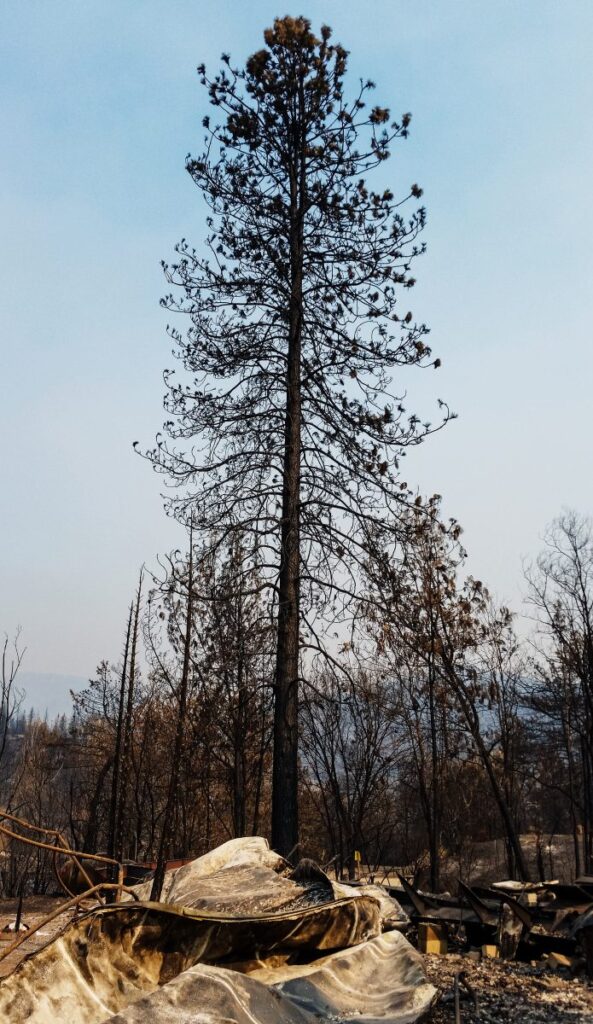From his overlook above the Shasta Dam, Chuck Roberson watched 2018’s Carr Fire slip into his community. Roberson, a security guard, was eyeing the area’s security cameras when he saw the wildfire approaching. He watched as it came up over the hill and then down toward the dam. Soon, a fire tornado erupted above the Kennewick Lake Reservoir in front of him. Within moments, he realized the fire had also jumped the lake.
Then, he picked up the phone and called the 80-year-old Vietnam veteran who was renting Roberson’s mobile home to make sure he was aware and getting out.
“He really didn’t take anything. He just got in his car and drove away, which was good, at least he was aware to do that,” said Roberson. “Little did any of us know that it would just completely annihilate the entire community. I mean everything out there but like two houses in the area was just incinerated.”

Later, when Roberson called his mother and urged her to leave her home, he asked her to take the family picture albums with her. Because she wasn’t in imminent danger, she had a little time to gather things and then evacuate. It wouldn’t be until later—until after Roberson had to call his mother with the bad news that her house had burned—that he’d learn she’d left the albums behind. Across the county, when Roberson’s tenant fled, he left all of his belongings—including his critical medications—behind as well.
A New Fire Evacuation Plan Emerges
That habit of not taking anything, or not taking critical items, while evacuating is one of the things Roberson wishes he had known about surviving a disaster. In the future, Roberson would urge people to gather those critical things—like Army discharge papers, a family picture album, and daily medications—in advance of a disaster so they are easy to grab in an emergency evacuation.
“It’s hard to comprehend because you don’t think a wildfire is going to come through,” he said. “There was a huge fire break all around the entire place, but the intensity and the winds I guess took everything, and the whole community … It was nothing I could have ever imagined.”

Looking back, collecting items for evacuation isn’t the only thing he would advise others to do differently. He himself would have had a better insurance property. And, he would have double-checked his mother’s insurance, too. It was only after the fire destroyed her entire home that he learned his mother had dropped hers a couple of years prior. That he would have fixed had he known. He also learned that while most homes undergo a policy reevaluation every year, it’s mandated for manufactured or mobile homes. Roberson, in turned out, was himself underinsured. The meager payout he did receive wouldn’t go far.
When Roberson set his home up 30 years ago the cost to do so was low, albeit labor-intensive. In the three decades since, the cost of installing a manufactured or mobile on his property has skyrocketed, he says. “Now, the cost to do the setup of it is right around $15,000 to $16,000, which is hard to imagine, because I know it wasn’t more than maybe $1,000 or $2,000 when I did it that many years ago.”
Better insurance would have limited Roberson’s debt load to rebuild, which he chose to do even though he no longer occupied the property himself.
Taking Out A Loan to Help A Veteran
A few months after the fire, that retired veteran tenant reached out and asked if Roberson would put a trailer up there, for him to live in again. Roberson was shocked. Had the man seen what was left of the land after the fire? In fact, he had.
“‘I know,’ he told me, ‘but it’s my home and I want to be there’,” Roberson explained. Then, he put himself in the man’s position. Losing everything, even at his age—he’s 50—would be devastating. It would be, he thought, so detrimental that it might be impossible to recover.
And so, Roberson took out a loan of his own.
“I just thought, you know what I’m going to do it,” said Roberson. “I don’t know how long he will live, but until he takes his last breath, I want him to have a place that is home.”
Roberson installed a new trailer on the site in 2019, and his tenant moved in shortly thereafter. This time, however, Roberson has ensured he has appropriate insurance—and that his tenant will have his most important items on hand if he ever has to evacuate again.
Three Steps to Take Before a Disaster Strikes
Make an Emergency Preparedness Kit
A good emergency preparedness kit has enough supplies—such as water, medications, and some food rations—to see you through a couple of days living without electricity, water, or in a strange location.
Make an Extended Evacuation Kit
In addition to an emergency kit with basic living supplies, create a kit that includes things you must have, or would like to have, if you aren’t ever able to return home. This might include medications, important papers or documents, and something of sentimental value. Then, have it ready to grab if you need to leave immediately.
Check Your Homeowner’s or Renter’s Insurance
Know your policy and have yourself and your home insured to the best extent possible. If you lose everything, will your insurance policy at least give you enough to try to start over?



